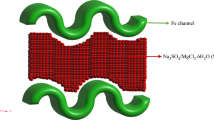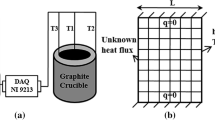Abstract
Melting temperatures and eutectic mixture compositions of LiNO3–LiClO4–H2O, NaNO3–Ca(NO3)2–H2O and NH4NO3–Mn(NO3)2–Mg(NO3)2–H2O systems were predicted using the modified Brunauer, Emmett and Teller (BET) thermodynamic model. For the ternary system with calcium nitrate and for the quaternary system, it was necessary to estimate the Ωij mixing parameters with solid–liquid equilibrium data, which quantify the interaction between the compounds NaNO3–Ca(NO3)2 and NH4NO3–Mn(NO3)2, respectively. The results calculated with the modified BET thermodynamic model show melting temperatures of 28.3 °C and 27.0 °C for the system with lithium perchlorate, 33.2 °C for the system with calcium nitrate and 4.0 °C for the quaternary system. Calculated values were tested experimentally with the T-history method for the LiNO3–LiClO4–H2O and NH4NO3–Mn(NO3)2–Mg(NO3)2–H2O systems and with the DSC method for the NaNO3–Ca(NO3)2–H2O system. The experimental results of eutectic mixtures predicted in this work present a good thermal behavior and can be useful as phase change materials (PCM) for their application in the design and simulation of refrigeration and air conditioning systems in residential and commercial buildings.
Graphic abstract











Similar content being viewed by others
References
Hou Y, Vidu R, Stroeve P. Solar energy storage methods. Ind Eng Chem Res. 2011;50:8954–64.
Sharma A, Tyagi VV, Chen CR, Buddhi D. Review on thermal energy storage with phase change materials and applications. Renew Sust Energ Rev. 2009;13:318–45.
Prabhu PA, Shinde NN, Patil PS. Review of phase change materials for thermal energy storage applications. Int J Eng Res Appl (IJERA). 2012;3:871–5.
Murat K, Khamid M. Solar energy storage using phase change materials. Renew Sust Energ Rev. 2007;11:1913–65.
Zalba B, Marín JM, Cabeza LF. Review on thermal energy storage with phase change: materials, heat transfer analysis and applications. Appl Therm Eng. 2003;23:251–83.
Farid MM. A review on phase change energy storage: materials and application. Energ Convers Manag. 2004;45:1597–615.
Hua W, Zhang X, Han X. Preparation of modified sodium acetate trihydrate and the thermodynamic analysis. J Therm Anal Calorim. 2019;136:1173–83.
He Y, Zhang N, Yuan Y, Cao X, Sun L, Song Y. Improvement of supercooling and thermal conductivity of the sodium acetate trihydrate for thermal energy storage with α-Fe2O3. J Therm Anal Calorim. 2018;133:859–67.
Gao D, Deng T. Energy storage: preparations and physicochemical properties of solid-liquid phase change materials for thermal energy storage. Curr Res Technol Dev. 2013;1:32–44.
Zeng D, Voigt W. Phase diagram calculation of molten salt hydrates using modified BET equation. Calphad. 2003;27:243–51.
Zeng D, Liu H, Chen Q. Simulation and prediction of solubility phase diagram for the separation of MgCl2 from LiCl brine using HCl as a salting-out agent. Hydrometallurgy. 2007;89:21–31.
Ally MR, Braunstein J. Statistical mechanics of multilayer adsorption: electrolyte and water activities in concentrated solutions. J Chem Thermodyn. 1998;30:49–58.
Voigt W, Deng D. Solid–liquid equilibria in mixtures of molten salt hydrates for the design of heat storage materials. Pure Appl Chem. 2002;74:1909–20.
Li B, Zeng D, Yin X, Chen Q. Theoretical prediction and experimental determination of room-temperature phase change materials using hydrated salts as agents. J Therm Anal Calorim. 2010;100:685–93.
Rains OW, Councert R. Liquidus curves of NH4NO3 (aq) calculated from the modified adsorption isotherm model for aqueous electrolytes. Sep Sci Technol. 2006;41:2629–34.
Schmit H, Rathgeber C, Hennemann P, Hiebler S. Three–step method to determine the eutectic composition of binary and ternary mixtures. J Therm Anal Calorim. 2014;117:595–602.
Zhou Q, Yin X, Wang Q, Wang C. Phase diagram prediction of the system Mg(NO3)2–MgCl2–H2O as phase change materials. Acta Chim Sinica. 2011;69:1725–30.
Zhang Y, Jiang Y, Jiang Y. A simple method, the T-history method, of determining the heat of fusion, specific heat and thermal conductivity of phase change materials. Meas Sci Technol. 1999;10:201–5.
Rathgeber C, Schmit H, Miró L, Cabeza LF, Gutierrez A, Ushak S, Hiebler S, Hauer A. Analysis of supercooling of phase change materials with increased sample size—comparison of measurements via DSC, T-History and at pilot plant scale. In: The 13th International conference on energy storage. Greenstock, 2015, Beijing China.
Xu X, Zhang X, Zhou S, Wang Y, Lu L. Experimental and application study of Na2SO4·10H2O with additives for cold storage. J Therm Anal Calorim. 2019;136:505–12.
Chang SJ, Wi S, Jeong SG, Kim S. Analysis on phase transition range of the pure and mixed phase change materials (PCM) using a thermostatic chamber test and differentiation. J Therm Anal Calorim. 2018;131:1999–2004.
Leitner J, Jurik S. DSC study and thermodynamic modelling of the system paracetamol–o-acetylsalicylic acid. J Therm Anal Calorim. 2017;130:1735–40.
Gutierrez A, Ushak S, Galleguillos H, Fernandez A, Cabeza LF, Grágeda M. Use of polyethylene glycol for the improvement of the cycling stability of Bischofite as thermal energy storage material. Appl Energy. 2015;154:616–21.
Ushak S, Gutierrez A, Galleguillos H, Fernandez AG, Cabeza LF, Grágeda M. Thermophysical characterization of a by-product from the non-metallic industry as inorganic PCM. Sol Energ Mat Sol C. 2015;132:385–91.
Nagano K, Ogawa K, Mochida T, Hayashi K, Ogoshi H. Thermal characteristics of magnesium nitrate hexahydrate and magnesium chloride hexahydrate mixture as a phase change material for effective utilization of urban waste heat. Appl Therm Eng. 2004;24:221–32.
Abraham M, Abraham MC. Electrolyte and water activities in very concentrated solutions. Electrochim Acta. 2000;46:137–42.
Zeng D, Ming J, Voigt W. Thermodynamic study of the system (LiCl + LiNO3 + H2O). J Chem Thermodyn. 2008;40:232–9.
Zeng D, Fan S, Chen S. Phase diagram prediction of systems Mn(NO3)2–M(NO3)n–H2O (M = Ca, Mg and Li) with modified BET model. J Chem Thermodyn. 2004;6:1192–8.
Yin X, Chen Q, Wang W, Zeng D. Phase diagram prediction of the quaternary system LiNO3–Mg(NO3)2–NH4NO3–H2O and research of related phase change materials. Chin J Inorgan Chem. 2012;28:1873–7.
Linke WF, Seidell A. Solubilities: inorganic and metal-organic compounds. Washington, DC: American Chemical Society; 1965.
Xu Y, Hepler GL. Calorimetric investigation of crystalline, molten, and supercooled Ca(NO3)2∙4H2O and of concentrated Ca(NO3)2 (aq). J Chem Thermodyn. 1993;25:91–7.
Guo L, Yu X, Gao D, Guo Y, Ma C, Deng T. Synthesis and thermal energy storage properties of a calcium-based room temperature phase change material for energy storage. J Therm Anal Calorim. 2019;135:3215–21.
Nazir H, Batool M, Osorio FJB, Isaza-Ruiz M, Xu X, Vignarooban K, Phelan P, Kannan AM. Recent developments in phase change material for energy storage applications: a review. Int J Heat Mass Transf. 2019;129:491–523.
Ushak S, Gutierrez A, Barreneche C, Fernandez AI, Grágeda M, Cabeza LF. Reduction of the subcooling of Bischofite with the use of nucleating agents. Sol Energy Mat Sol C. 2016;157:1011–8.
Acknowledgements
This work was supported by projects CONICYT/FONDAP Nº 15110019 SERC-Chile, CONICYT/ELAC2015/T06-0988 and CONICYT/FONDECYT/REGULAR Nº 1170675.
Author information
Authors and Affiliations
Corresponding author
Additional information
Publisher's Note
Springer Nature remains neutral with regard to jurisdictional claims in published maps and institutional affiliations.
Rights and permissions
About this article
Cite this article
Lovera-Copa, J.A., Ushak, S., Reinaga, N. et al. Design of phase change materials based on salt hydrates for thermal energy storage in a range of 4–40 °C. J Therm Anal Calorim 139, 3701–3710 (2020). https://doi.org/10.1007/s10973-019-08655-1
Received:
Accepted:
Published:
Issue Date:
DOI: https://doi.org/10.1007/s10973-019-08655-1




